DISPOSAL OF AMOUNT DUE TO RETIRING PARTNER
The partner who is retiring, his or her account is settled as per the terms and conditions of the partnership deed, i.e., in lump sum instantly or in different installments, either with or without interest as consented or partly in cash directly and partially in installment at the consented intermissions. In the absenteeism of any deed, Section 37 of the Indian Partnership Act, 1932 is pertinent, which states that the partner who is retiring or moving out, has a choice to receive interest @ 6% per annum until the date of payment or such share of gains which has been earned with his or her money (i.e., which is based on the capital ratio).
Therefore, the total amount overdue to the retiring partner which is determined after all the modifications and adjustments have been made is to be compensated instantly to the retiring or an outgoing partner. In case the enterprise is not in a situation to make the payment right away, the amount that is overdue is being transferred to the retiring or outgoing Partner’s Loan A/c. The required journal entries are recorded as follows :
When a retiring partner is paid cash in full :
Retiring Partner’s Capital A/c Dr.
To Cash/Bank A/c
When retiring partner’s whole amount is treated as loan:
Retiring Partner’s Capital A/c Dr.
To Retiring Partner’s Loan A/c
When a retiring partner is partly paid in cash and the remaining amount treated as loan :
Retiring Partner’s Capital A/c Dr. (Total amount due)
To Cash/Bank A/c (Amount Paid)
To Retiring Partner’s Loan A/c (Amount of Loan)
When Loan account is settled by paying in instalments includes principal and interest :
• For interest on loan
Interest A/c Dr.
To Retiring Partner’s Loan A/c
• For payment of installment
Retiring Partner’s Loan A/c Dr.
To Cash/Bank A/c
Death of a Partner:
The accounting treatment in the event of the death of a partner is the same as that in the case of the retirement of a partner. Here, his claim is transferred to his executor’s account and settled in the same manner as that of the retired partner.
The only major difference between the retirement and death of a partner is that retirement normally takes place at the end of the accounting period whereas death may occur on any day. Therefore, in case of death, his claim shall also include his share of profit or loss, interest on capital, and interest on drawings (if any), from the beginning of the year to the date of death.
Calculation of profit for the intervening period: Share of profit of a deceased partner
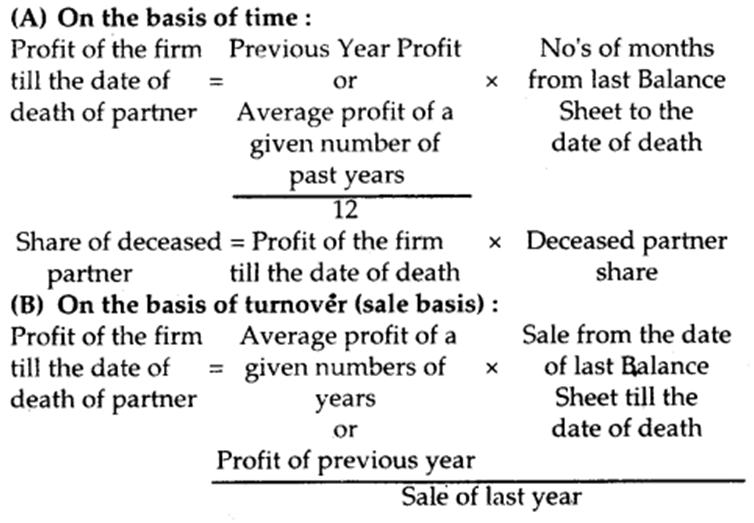
Share of deceased partner = Profit of the firm till the date of death × Deceased partner share
Accounting Treatment of Outgoing Partner’s Share in Profit:
1. Through Profit and Loss Suspense Account
In case of Profit:
Profit and Loss Suspense A/c Dr.
To Deceased Partner’s Capital A/c (Share of profit for the intervening period)
In case of Loss:
Deceased Partner’s Capital A/c Dr.
To Profit and Loss Suspense A/c (Share of loss for the intervening period)
2. Through Capital Transfer In case of Profit:
Remaining Partner’s Capital A/c’s Dr.
To Deceased Partner’s Capital A/c In case of Loss:
Deceased Partner’s Capital A/c Dr.
To Remaining Partner’s Capital A/c’s The executors of deceased partner are entitled to the following:
- The credit balance of deceased partner’s capital account;
- His share of goodwill;
- His share of profit till the date of death;
- His share of profit on revaluation of assets and liabilities;
- His share of accumulated profits and reserves;
- His interest in capital if partnership deed provides till the date of death;
- His share of Joint Life Policy (if any);
- His salary and commission due (if any);
The following deduction has to be made from above.
- His drawings, interest in drawings till the date of death;
- His share of loss till the date of death;
- His share of loss on revaluation of assets and liabilities. ,
- His share of the reduction in the value of goodwill (if any).
Payment to the executors:
1. When payment is made in full Executor’s A/c Dr.
To Bank A/c.
2. When payment is made in installments The executors are entitled to interest when the payment is made in installment. If the deed is silent about this, then 6% p.a. should be given as per Section 37 of the Indian Partnership Act, 1932.
When interest is due
Interest A/c Dr.
To Executor’s A/c
When installment paid along with interest
Executor’s A/c Dr.
To Cash/Bank A/c
- Books Name
- Vision classes Accountancy Book
- Publication
- Vision classes
- Course
- CBSE Class 12
- Subject
- Accountancy
Disposal of Amount Due to Retiring Partner
The outgoing partner’s account is settled as per the terms of partnership deed i.e., in lumpsum immediately or in various instalments with or without interest as agreed or partly in cash immediately and partly in instalment at the agreed intervals. In the absence of any agreement, Section 37 of the Indian Partnership Act, 1932 is applicable, which states that the outgoing partner has an option to receive either interest @ 6% p.a. till the date of payment or such share of profits which has been earned with his/her money (i.e., based on capital ratio). Hence, the total amount due to the retiring partner which is ascertained after all adjustments have been made is to be paid immediately to the retiring partner. In case the firm is not in a position to make the payment immediately, the amount due is transferred to the retiring Partner’s Loan Account, and as and when the amount is paid it is debited to his account. The necessary journal entries recorded are as follows.
1. When retiring partner is paid cash in full.
Retiring Partners’ Capital A/c Dr. To Cash/Bank A/c
2. When retiring partners’ whole amount is treated as loan.
Retiring Partners’ Capital A/c Dr. To Retiring Partners’ Loan A/c
3. When retiring partner is partly paid in cash and the remaining amount treated as loan.
Retiring Partners’ Capital A/c Dr. (Total Amount due) To Cash/Bank A/c (Amount Paid)
To Retiring Partners’ Loan A/c (Amount of Loan)
4. When Loan account is settled by paying in instalment includes principal and interest.
a) For interest on loan
Interest A/c Dr. To Retiring Partner’s Loan A/c
b) For payment of instalment
Retiring Partner’s Loan A/c Dr. To Cash/Bank A/c
Note:
4. When Loan account is settled by paying in instalment includes principal and interest.
a) For interest on loan
Interest A/c Dr. To Retiring Partner’s Loan A/c
b) For payment of instalment
Retiring Partner’s Loan A/c Dr. To Cash/Bank A/c
1. The balance of the retiring partner’s loan account is shown on the liabilities side of the Balance Sheet till the last instalment is paid to him/her.
2. Entry number (a) and (b), above will be repeated till the loan is paid off.
Revision 11
Amrinder, Mahinder and Joginder are partners in a firm. Mahinder retires from the firm. On his date of retirement, Rs. 60,000 becomes due to him. Amrinder and Joginder promised to pay him in instalments every year at the end of the year to which he agreed. Prepare Mahinder’s Loan Account in the following cases:
1. When payment is made four yearly instalments plus interest @ 12% p.a. on the unpaid balance.
2. When when payment is made in three yearly instalments of Rs. 20,000 including interest @ 12% p.a on the outstanding balance during the first three years and the balance including interest in the fourth year.
3. When payment is made in 4 equal yearly instalment’s including interest @ 12% p.a. on the unpaid balance.
Solution
(a) When payment is made in four yearly instalments plus interest
Books of Amrinder and Joginder
Mahinder’s Loan Account
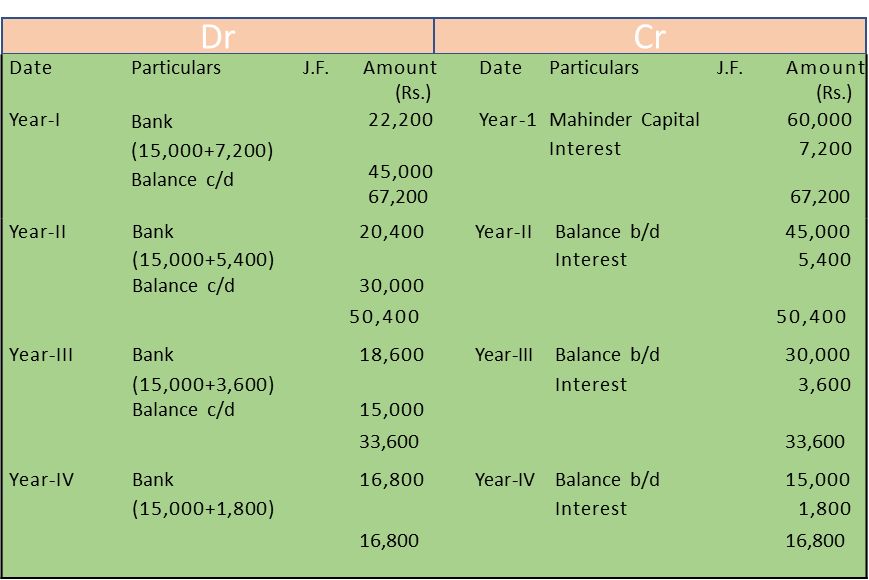
(b) When payment is made in three yearly instalments of Rs. 20,000 each including interest.
Books of Amrinder, Mahinder and Joginder
Mahinder’s Loan Account
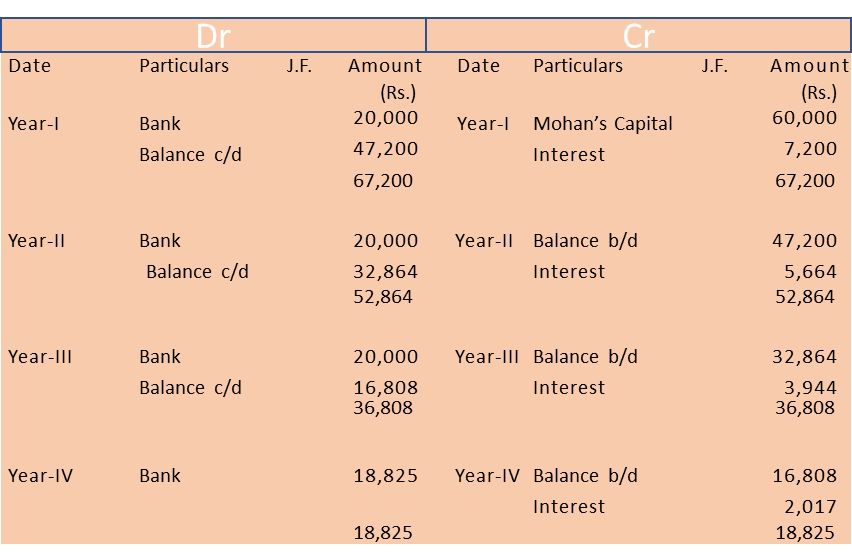
(c) When payment is made in four equal yearly instalments including interest @12% (Annually).
Books of Amrinder and Joginder
Mahinder’s Loan Account
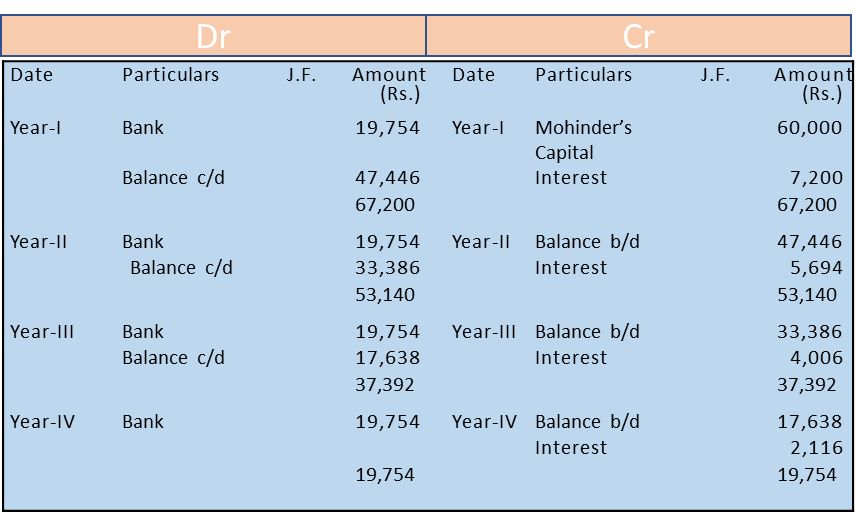
Note:
The annual instalment of payment in 4 years @ 12% interest works out at Rs. 19,754 (Annually of Rs. 0.329234 as per Annually Table x 60,000).
It may noted that the accounting treatment for disposal of amount due to retiring partner and deceased partner is similar with a difference that in case of death of a partner, the amount credited to him/her is transferred to his Executors’ Account and the payment has to be made to him/her. This shall be taken up later in this chapter.
Revision 12
The Balance Sheet of Ashish, Suresh and Lokesh who were sharing profits in the ratio of 5 : 3 : 2, is given below as on March 31, 2017.
Balance Sheet of Ashish, Suresh and Lokesh As on March 31, 2017
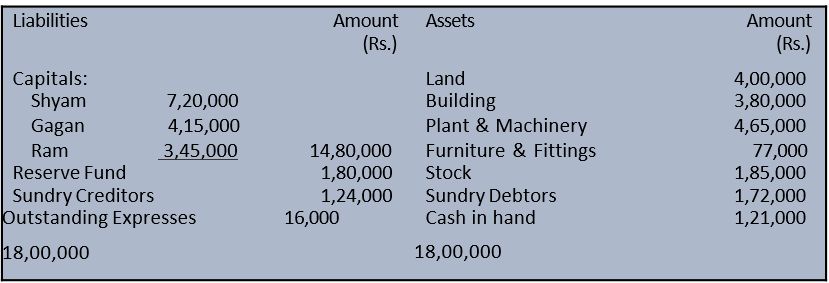
Suresh retires on June 30, 2017 date and the following adjustments are agreed upon his retirement.
1. Stock was valued at Rs. 1,72,000.
2. Furniture and fittings were valued at Rs. 80,000
3. Profit share of Suresh till the date of his retirement is to be calculated on the basis of firm's last year profit which is Rs. 2,00,000.
4. An amount of Rs. 10,000 due from Mr. Deepak, a debtor, was doubtful and a provision for the same was required.
5. Goodwill of the firm was valued at Rs. 2,00,000.
6. Suresh was paid Rs. 40,000 immediately on retirement and the balance was transferred to his loan account.
7. Ashish and Lokesh were to share future profits in the ratio of 3:2.
Prepare Revaluation Account, Capital Account and Balance Sheet of the reconstituted firm.
Solution
Books of Ashish, Suresh and Lokesh
Revaluation Account
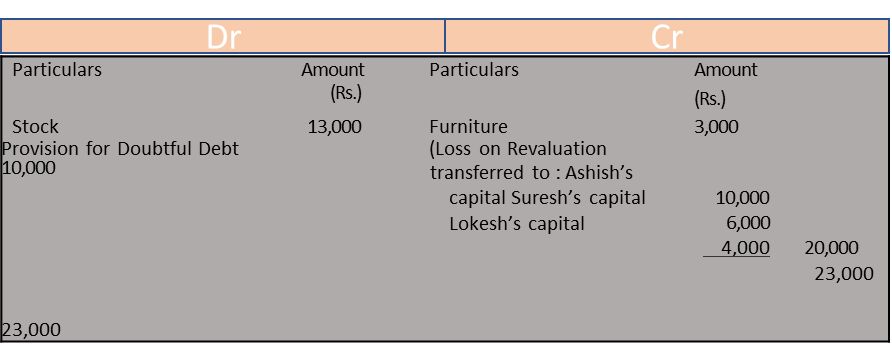
Partners’ Capital Accounts
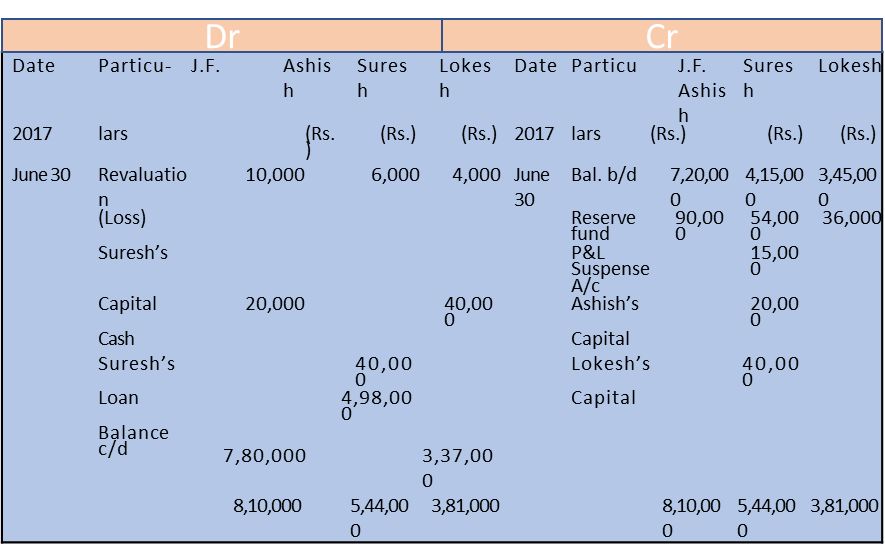
Balance Sheet of Ashish and Lokesh as on April 01, 2017
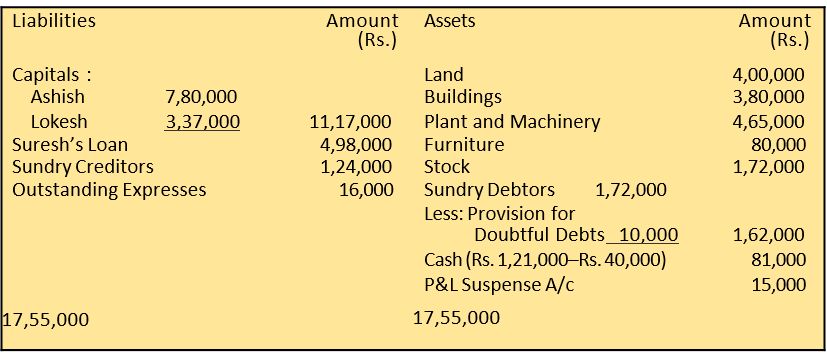
Working Notes
1. Gaining Share = New Share – Old Share
Ashish’s Gain = 3/5 – 5/10 = 6/10 - 5/10 = 1/10
Lokesh’s Gain = 2/5 – 2/10 = 4/10 – 2/10 = 2/10
Gaining Ratio between Ashish and Lokesh = 1 : 2,
2. Suresh’s Share of Goodwill = 3/10 × Rs. 2,00,000 = Rs. 60,000
3. Suresh's share of profit = 2,00,000 × 3/13 × 3/10 = Rs. 15,000
Revision 13
Shyam, Gagan and Ram are partners sharing profit in the ratio of 2 : 2 : 1.
Their Balance Sheet as on March 31, 2017 are as under:
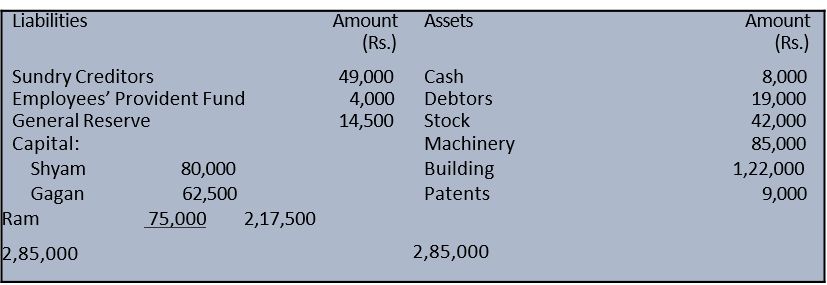
As Gagan got a very good break at an MNC, so he decided to retire on that date and it was decided that Shyam and Ram would share the future profits in the ratio of 5 : 3. Goodwill was valued at Rs. 70,000; Machinery at Rs. 78,000; Buildings at Rs. 1,52,000; stock at Rs. 30,000; and bad debts amounting to Rs. 1,550 were to be written off. Record journal entries in the books of the firm and prepare the Balance Sheet of the new firm.
Solution
Books of Shyam, Ram and Gagan
Journal

Balance Sheet of Shyam and Ram as on March 31, 2017

Working Notes
Share Gained = New Share – Old Share
Shyam’s Gain = 5/8 – 2/5 = 25/40 – 16/40 = 9/40
Ram’s Gain = 3/8 – 1/5 = 15/40 – 8/40 = 7/40
Therefore, Gaining Ratio of Shyam and Ram = 9 : 7.
Revaluation Account
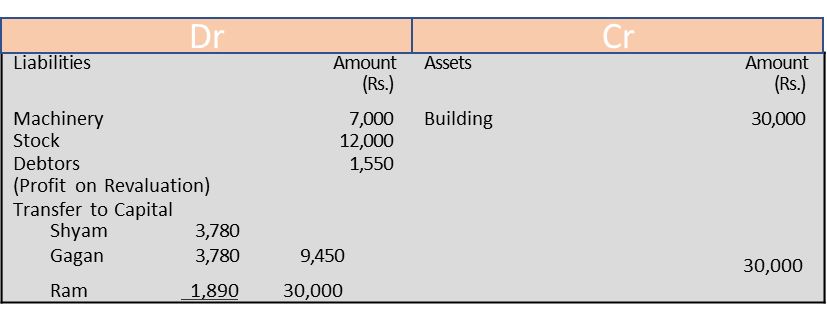
Partners’ Capital Accounts

Note: As sufficient balance is not available to pay the due amount to Gagan, the balance in his capital account is transferred to his loan account.
Adjustment of Partners’ Capitals
At the time of retirement or death of a partner, the remaining partners may decide to adjust their capital contributions in their profit sharing ratio. In such a situation, the sum of balances in the capitals of continuing partners may be treated as the total capital of the new firm, unless specified otherwise. Then, to ascertain the new capital of the continuing partners, the total capital of the firm is divided amongst the remaining partners as per the new profit sharing ratio, and the excess or deficiency of capital in the individual capital account’s may be worked out. Such excess or shortage shall be adjusted by withdrawal of contribution in cash, as the case may be, for which the following journal entries will be recorded.
(i) For excess capital withdrawn by the partner :
Partners’ Capital A/c Dr. To Cash / Bank A/c
(ii) For amount of capital to be brought in by the partner:
Cash / Bank A/c Dr. To Partners’ Capital A/c
Consider the following situations:
The adjustment of the continuing partner’s capitals may involve any one of the three ways as illustrated as follows :
1. When the capital of the new firm as decided by the partners is specified.
Revision 14
Mohit, Neeraj and Sohan are partners in a firm sharing profits in the ratio of 2 : 1 : 1. Neeraj retires and Mohit and Sohan decided that the capital of the new firm will be fixed at Rs. 1,20,000. The capital accounts of Mohit and Sohan show a credit balance of Rs. 82,000 and Rs. 41,000 respectively after making all the adjustments. Calculate the actual cash to be paid off or to be brought in by the continuing partners and pass the necessary journal entries.
Solution
The New Profit Sharing Ratio between Mohit and Sohan = 2 : 1

Books of Mohit and Sohan
Journal

2. When the total capital of new firm is not specified.
Revision 15
Asha, Deepa and Lata are partners in a firm sharing profits in the ratio of 3 : 2 : 1. Deepa retires. After making all adjustments relating to revaluation, goodwill and accumulated profit etc., the capital accounts of Asha and Lata showed a credit balance of Rs. 1,60,000 and Rs. 80,000 respectively. It was decided to adjust the capitals of Asha and Lata in their new profit sharing ratio. You are required to calculate the new capitals of the partners and record necessary journal entries for bringing in or withdrawal of the necessary amounts involved.
Solution
Calculation of new capitals of the existinging partners
Balance in Asha’s Capital (after all adjustments) = 1,60,000
Balance in Lata’s Capital = 80,000
Total Capital of the New Firm = 2,40,000
Based on the new profit sharing ratio of 3:1
Asha’s New Capital = Rs. 2,40,000 × ¾ = 1,80,000
Lata’s New Capital = Rs. 2,40,000 × ¼ = 60,000
Note :The total capital of the new firm is based on the sum of the balance in the capital accounts of the continuing partners.
Calculation of cash to be brought in or withdrawn by the continuing partners :

Cash to be brought in on (paid off)
Books of Asha and Lata
Journal

3. When the amount payable to retiring partner will be contributed by continuing partners in such a way that their capitals are adjusted proportionate to their new profit sharing ratio:
Revision 16
Lalit, Pankaj and Rahul are partners sharing profits in the ratio of 4 : 3 : 3. After all adjustments, on Lalit’s retirement with respect to general reserve, goodwill and revaluation etc., the balances in their capital accounts stood at Rs. 70,000, Rs. 60,000 and Rs. 50,000 respectively. It was decided that the amount payable to Lalit will be brought by Pankaj and Rahul in such a way as to make their capitals proportionate to their profit sharing ratio. Calculate the amount to be brought by Pankaj and Rahul and record necessary journal entries for the same. Also record necessary entry for payment to Lalit.
After Lalit’s retirement, the new profit sharing ratio between Pankaj and Rahul is 3 : 3, i.e. 1 : 1.
Solution
Calculation of total capital of the new firm
Balance in Pankaj’s Capital account (after adjustment) = 60,000
Balance in Rahul’s Capital account (after adjustment) = 50,000
Amount payable to Lalit (Retiring partner) = 70,000
Total capital of new firm (i) + (ii) + (iii) = 1,80,000
Calculation of new capitals of the continuing partners
Pankaj’s New Capital = Rs. 1,80,000 × ½ = Rs. 90,000
Rahul’s New Capital = Rs. 1,80,000 × ½ = Rs. 90,000
Calculation of the amounts to be brought in or withdrawn by the continuing partners

Books of Pankaj and Rahul
Journal

Revision 17
The Balance Sheet of Mohit, Neeraj and Sohan who are partners in a firm sharing profits according to their capitals as on March 31, 2017 was as under:
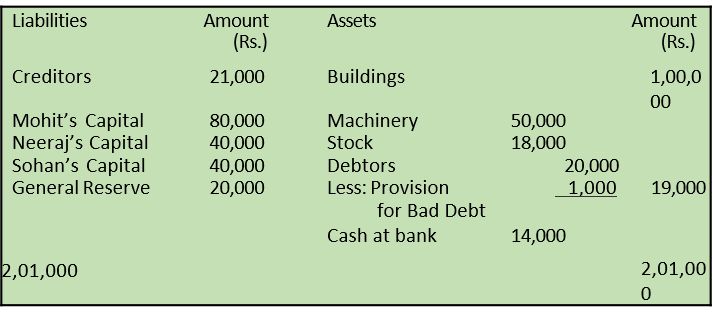
On that date, Neeraj decided to retire from the firm and was paid for his share in the firm subject to the following:
1. Buildings to be appreciated by 20%.
2. Provision for Bad debts to be increased to 15% on Debtors.
3. Machinery to be depreciated by 20%.
4. Goodwill of the firm is valued at Rs. 72,000 and the retiring partner’s share is adjusted through the capital accounts of remaining partners.
5. The capital of the new firm be fixed at Rs. 1,20,000.
Prepare Revaluation Account, Capital Accounts of the partners, and the Balance Sheet after retirement of B.
Solution
Revaluation Account
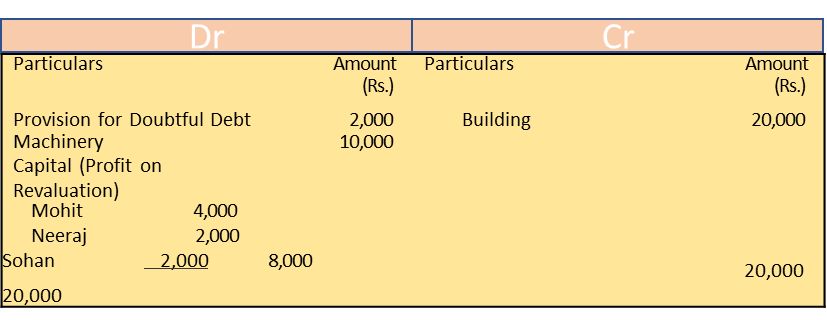
Partners’ Capital Accounts
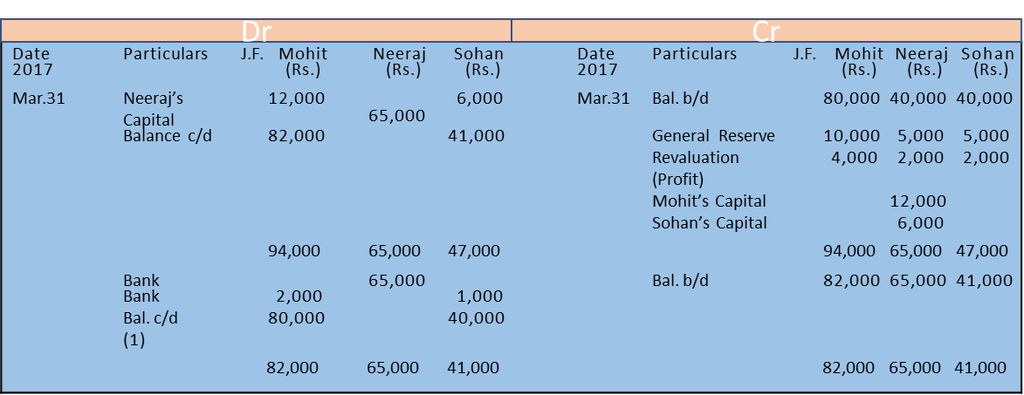
Balance Sheet as on March 31, 2017
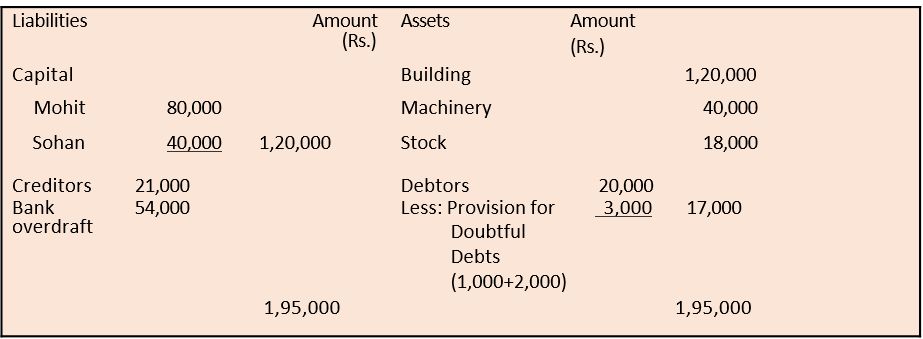
Working Notes
Bank Account

It is assumed that bank overdraft is taken to pay the retiring partners.
Cash to be brought in or withdrawn by Mohit and Sohan :

Death of a Partner
As stated earlier, the accounting treatment in the event of death of a partner is similar to that in case of retirement of a partner, and that in case of death of a partner his claim is transferred to his executors and settled in the same manner as that of the retired partner. However, there is one major difference that, while the retirement normally takes place at the end of an accounting period, the death of a partner may occur any time. Hence, in case of a partner, his claim shall also include his share of profit or loss, interest on capital, interest on drawings (if any) from the date of the last Balance Sheet to the date of his death of these, the main problem relates to the calculation of profit for the intervening period (i.e., the period from date of the last balance sheet and the date of the partner’s death. Since, it is considered cumbersome to close the books and prepare final account, for the period, the deceased partner’s share of profit may be calculated on the basis of last year’s profit (or average of past few years) or on the basis of sales.
For example, Bakul, Champak and Darshan were partners in a firm sharing profits in the ratio of 5:4:1. The profit of the firm for the year ending on March 31, 2017 was Rs.1,00,000. Champak died on June 30, 2017. Bakul and Darshan decided to share profits equally. Champak’s share of profit for the period from
April 1 to June 30, 2017, shall be calculated as follows:
Total profit for the year ending on 31st March, 2017 = Rs.1,00,000
Champak’s share of profit :
Proceeding Year’s Profit × Proportionate Period × Share of Deceased Partner
= Rs. 1,00,000 × 3/12 × 4/10 = Rs. 10,000
The journal entry will be recorded as follows :
Profit & Loss Suspense A/c Dr. 10,000
To Champak’s Capital A/c 10,000
(Champak’s share of profit transferred to his capital account)
Alternatively, if Champak’s share of profit was to be calculated on the basis of average profits of the last three years, which were Rs. 1,36,000 for 2014-15, Rs. 1,54,000 for 2015-16 and Rs. 1,00,000 for 2016-17; Champahs share of profit for the period from April 7, 2017 to June 30, 2017 shall be calculated on the basis of average profit based on profits for the last year calculation as follows:
Average Profit = Total Profit / No. of years
= Rs. 1,36,000 + Rs. 1,54,000 + Rs. 1,00,000
3
= Rs. 3,90,000
3
= Rs. 1,30,000
Champak’s share of profit = Rs. 1,30,000 × 3/12 months × 4/10 months
= Rs. 13,000
The Journal entry will be:
Profit & Loss Suspense A/c Dr. 13,000
To Champak's Capital A/c 13,000
In case, the agreement provides, that share of profit of the deceased partner will be worked out on the basis of sales, and it is specified that the sales during the year 2015-16 were Rs. 8,00,000 and the sales from April 1, 2017 to June 30, 2017 were Rs. 1,50,000 Champak’s share of profits for the period from
April 1, 2017 to June 30, 2017 shall be calculated as follows.
If sale is Rs.8,00,000, the profit = Rs.1,00,000
If sale is Rs.1, the profit = 1,00,000
8,00,000
If sale is Rs.1,50,000, the profit = 1,00,000 X 1,50,000
8,00,000
= Rs. 18,750
Champak’s share of profit = Rs. 7,500
The Journal entry will be:
Profit & Loss Suspense A/c Dr. 2,500
To Champak's Capital A/c 7,500
For being deceased partner’s share of profits for the intervening period to books of account, the following journal entry is recorded.
(i) Profit and Loss (Supense) A/c Dr.
To Deceased Partner’s Capital A/c
(Share of profit for the intervening period)
Later Profit and Loss Suspense account is closed by transferring the account to
Gaining Partners' Capital Account in their gaining ratio. The journal entry is:
(ii) Gaining Partners Capital A/c [In gaining ratio] To Profit and Loss Suspense A/c
(P&L Suspense account transferred).
Alternatively the following journal entry can also be passed in Place of (i) & (ii)
(ii) Gaining Partners' Capital A/c Dr.
To Deceased Partner Capital A/c
(share of profit of Deceased Partner credited)
Revision 18
Anil, Bhanu and Chandu were partners in a firm sharing profits in the ratio of 5:3:2. On March 31, 2017, their Balance Sheet was as under:
Books of Anil, Bhanu and Chandu
Balance Sheet as on March 31, 2017
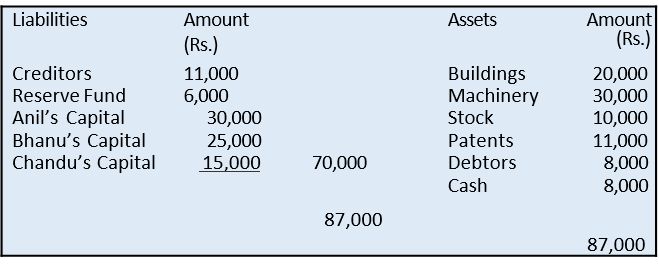
Anil died on October 1, 2017. It was agreed between his executors and the remaining partners that :
(a) Goodwill to be valued at 2 12 year’s purchase of the average profits of the previous four years which were :
Year 2013-14 – Rs.13,000, Year 2014-15 – Rs. 12,000, Year 2015-16 – Rs.20,000, Year 2016-17 – Rs.15,000
(b) Patents be valued at Rs.8,000; Machinery at Rs.28,000; and Building at Rs.25,000.
(c) Profit for the year 2017-18 be taken as having accrued at the same rate as that of the previous year.
(d) Interest on capital be provided at 10% p.a.
(e) Half of the amount due to Anil be paid immediately.
Prepare Anil’s Capital Account and Anil’s Executor’s Account as on October 1, 2017.
Solution
Books of Anil, Bhanu and Chander
Anil’s Capital Account
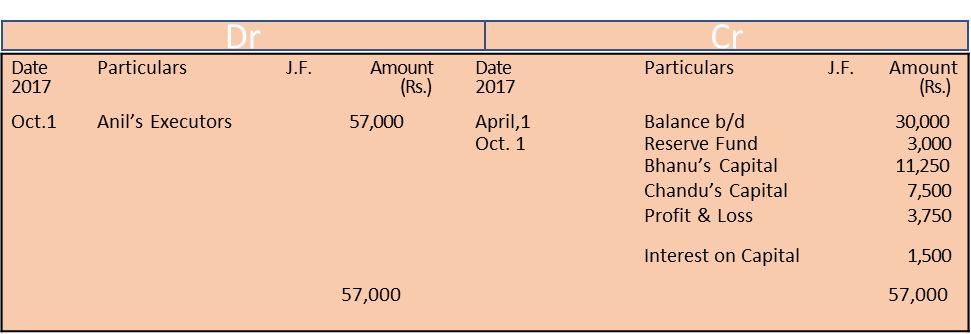
Anil’s Executor’s Account

Working Notes
Revaluation Account

Goodwill = 2½ years’ purchase × Average Profit
Average Profit = Rs. 13,000 + Rs.12,000 + Rs.20,000 + Rs.15,000
4
= Rs. 60,000
4
= Rs. 15,000
Goodwill = 5/2 × Rs. 15,000
= Rs. 37,500
Anil’s Share of Goodwill = 5/10 × Rs. 37,500
= Rs. 18,750
3. Profit from the date of last balance sheet to date of death (April 1, 2017 to October 1, 2017)
= 6 months
Profit for 6 months = Rs. 15,000 × 6/ 12 = Rs. 7,500
Anil’s share of profit = Rs. 7,500 × 5 / 10 = Rs. 3,750
4. Interest on Capital
(April 1, 2017 to October 1, 2017)
= Rs. 30,000 × 10 / 100 × 6 / 12
= Rs.1,500
Revision 19
You are given the Balance Sheet of Mohit, Sohan and Rahul who are partners sharing profits in the ratio of 2 : 2 : 1, as on March 31, 2017.
Books of Mohit, Sohan and Rahul
Balance Sheet as on March 31, 2017.
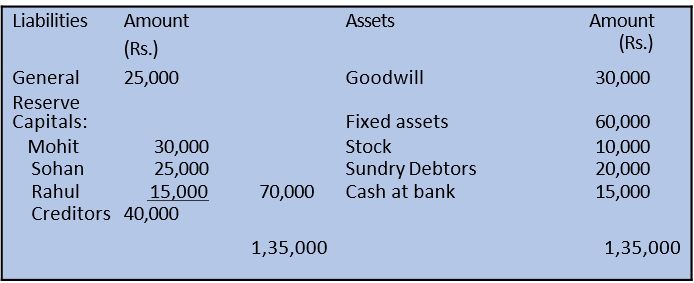
Sohan died on June 15, 2017. According to the Deed, his legal representatives are entitled to:
(a) Balance in Capital Account;
(b) Share of goodwill valued on the basis of thrice the average of the past 4 years’ profits.
(c) Share in profits up to the date of death on the basis of average profits for the past 4 years.
(d) Interest on capital account @ 12% p.a.
(e) New Profit sharing ratio of the firm will be 3:2 among Mohit and Rahul respectively.
Profits for the years ending on March 31 of 2014, 2015, 2016, 2017 respectively were Rs. 15,000, Rs. 17,000, Rs. 19,000 and Rs. 13,000.
Sohan’s legal representatives were to be paid the amount due. Mohit and Rahul continued as partner by taking over Sohan’s share equally. Work out the amount payable to Sohan’s legal representatives.
Solution
Books of Mohit, Sohan and Rahul
Sohan’s Capital Account

Working Notes
1. Sohan’s Share of Goodwill
= Goodwill of the Firm × 2 / 5
= Rs. 48,000 × 2 / 5 = Rs. 19,200
Goodwill of the Firm = 3 × Average Profit
= 3 × Rs. 64,000 / 4 = Rs. 48,000
2. Profit and Loss
(Share of Profit from the date of last Balance Sheet to the date of death) 2 ½ months.
= Rs. 64,000 / 4 × 2 / 5 × 2.5 / 12
= Rs. 1,333
3. Interest on Capital
= Rs. 25,000 × 12 /100 × 25/ 12 = Rs. 625
Summary
- New Profit Sharing Ratio: New profit sharing ratio is the ratio in which the remaining partner will share future profits after the retirement or death of any partner. New Share = Old Share + Acquired Share from the Outgoing partnerGaining Ratio: Gaining ratio is the ratio in which the continuing partners have acquired the share from the retiring deceased partner.
- Treatment of Goodwill: The basic rule is that gaining partner(s) shared compensate the sacrificing partner to the extent of their gain for the respective share of goodwill. If goodwill already appears in the books, it will be written off by debiting all partners’ capital account in their old profit sharing ratio.
- Revaluation of Assets and Liabilities: At the time of retirement/death of a partner, there may be some assets which may not have been shown at their current values. Similarly, there may be certain liabilities which have been shown at a value different from the obligation to be met by the firm. Besides this, there may be unrecorded assets and liabilities which have to be recorded.
- Accumulated Profits or Losses: The reserves (Accumulated profits) or losses belong to all the partners and should be transferred to capital account of all partners.
- Retiring partner/deceased partner may be paid in one lump sum or installments with interest.
- At the time of retirement/death of a partner, the remaining partner may decide to keep their capital contributions in their profit sharing ratio.

 SUDIP CHAKRABORTY
SUDIP CHAKRABORTY
